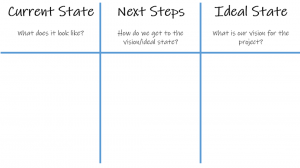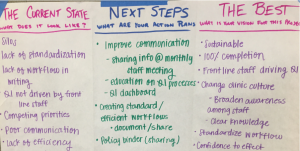
A recent Harvard Business Review article by Rosabeth Moss Kanter, Leading Your Team Past the Peak of a Crisis, discusses “Kanter’s Law” – how projects can look like failure when you’re in the middle of the effort – in the context of organizational and global crises.
Kanter offers up three strategies leaders can use to persevere through the obstacles and challenges they face as they navigate through the middle of a crisis:
- Setting the Right Tone: Communicate through the crisis with a genuine voice– messages of assurance where possible, owning when there aren’t known answers, and reaffirming a focus on the organization’s mission and values.
- Promote Collaboration and Prioritize Problems to Address: Build and empower teams to collaborate across roles, to assess the current situation and prioritize problem solving, and to rapidly adapt and innovate.
- Orient Staff to the Longer-Term Future: While stabilizing the “now,” design what’s next: a new vision to pursue and to provide staff energy to focus on the future.
While usually not of the magnitude of a crisis, we’ve seen and experienced the messy middle of many improvement projects – e.g., staff changes, measures not heading in the desired direction, lost momentum, etc. We’ve also seen how similar strategies and skills applied by QI teams when they reach the messy middle can assess the problem, prioritize the area to focus on and drive changes toward the new aim or vision.
Over the last few weeks we’ve heard from many of our alumni about how their organizations have been able to leverage their quality improvement teams and expertise to respond to the COVID-19 crisis, to promote collaboration and prioritize problems to address. Their ability to use root cause analysis tools (e.g., fishbone diagrams [download here]), to create priority matrices [download here] to help identify where to focus, and to draft plans to pilot and test solutions [download here] have helped teams roll out new programs and workflows quickly throughout their organizations.
Bridging the Vision & Current State
If you’ve joined any of IHQC’s learning communities in the past, you’ve likely participated in a “project tune-up” where, to help teams overcome some of the obstacles and frustrations commonly experienced in the middle of a project, we revisit the project’s longer-term vision. We use an exercise in three parts to visualize how to bridge between the Vision and the Current State (download guide here).
 Teams begin by describing what the idea/future state would look like after the project is completed. Next, they candidly discuss what the current state really looks like. Teams then brainstorm and document next steps and actions the team can take to “bridge” the Current State to the Vision/Ideal State.
Teams begin by describing what the idea/future state would look like after the project is completed. Next, they candidly discuss what the current state really looks like. Teams then brainstorm and document next steps and actions the team can take to “bridge” the Current State to the Vision/Ideal State.
 Teams have found this helpful to reorient themselves to the vision, acknowledge what is and isn’t working well in the current state, and then pivot to concrete actions and steps they can take to overcome some of the challenges in the messy middle, to help move the team closer to the ideal state.
Teams have found this helpful to reorient themselves to the vision, acknowledge what is and isn’t working well in the current state, and then pivot to concrete actions and steps they can take to overcome some of the challenges in the messy middle, to help move the team closer to the ideal state.
IHQC has witnessed a fair amount of change – and meaningful transformation – over the years, even in the face of tremendous adversity and uncertainty. The gravity of our current environment certainly presents more significant changes and challenges than the typical improvement project. But time and time again, we see you “…persist, pivot, and persevere…”, ultimately emerging on the other side with new skills, strengths, strategies, and innovations that allow you to continue caring for the communities who need it most.
Program Announcement:
Making the Value Connection – Los Angeles
Application Deadline Extended to Monday, May 11!
The Making the Value Connection Program (MVC) was developed to support community health centers in preparing for changing payment methodologies. Led by IHQC and Capital Link, the program consists of direct coaching, workshops, roundtable meetings, tools, assessments, and other resources to guide participants in improving value and finding balance between quality and financial sustainability.
The MVC Program is free to safety net clinics based in Los Angeles County, thanks to the generous support of Cedars-Sinai.
Please download the MVC Program Overview and Application here for additional details on how to participate.
If you’d like to share a story of your improvement work, a resource that you find helpful, or just a quick note, please reach out to us at info@IHQC.org.
